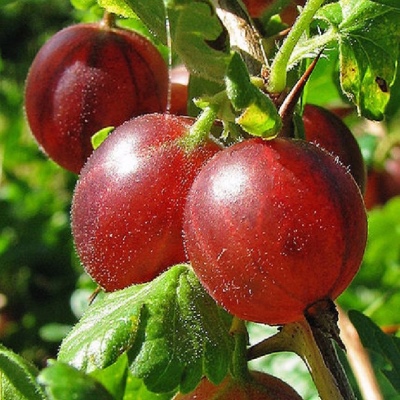
- Authors: All-Russian Research Institute of Horticulture named after I.V. Michurin
- Growth type: vigorous
- Description of the bush: slightly spreading
- Escapes: powerful, curved, light green
- Thorniness: medium
- Thorns: single
- Flowers: pale
- Berry size: medium and large
- Berry weight, g: 3,0-6,0
- Berry shape: oval or elliptical
When choosing gooseberries for planting in the country, many gardeners prefer varieties that have been proven for decades. These include the mid-late type Russian red, which gives stable and good yields.
Breeding history
Russian red gooseberry is a variety with a long history, created by the breeder KD Sergeeva of the V.I. I.V. Michurin in 1949. To create the variety, Kareles and (Oregon x Houghton x Curry) were used. After 10 years, the Russian berry culture was included in the State Register of Breeding Achievements of the Russian Federation, and also allowed for use. The variety has been zoned to all regions of the country, except for the Urals.
Description of the variety
Russian red is a vigorous plant, stretching up to 150-180 cm in height. The bushes have a moderate thickening of the crown with bright green leaves, weak branching, powerful curved shoots and medium studding with single thorns. At a young age, the shrub is quite sprawling, and then becomes compact. Small elongated buds grow, deviating from the shoot. The flower cluster of the bush consists of several flowers of a pale color.
The variety is highly self-fertile, so it can be grown in single plantings.
Characteristics of berries
The Russian red gooseberry represents a class of medium-fruited berries, although in some sources it is noted as a large-fruited species. The average berry weight is 3-6 grams. The gooseberry is characterized by an oval or elliptical shape with a smooth surface without edges, but with a noticeable waxy bloom. The color of the berries is beautiful - dark red with lightened veins on the skin. The gooseberry rind is dense with pronounced venation.
The transportability of the berries is good, and the keeping quality is not bad. Ripe berries can be stored in the refrigerator for up to 4 days, and harvested at the stage of technical maturity - up to 10 days. The purpose of the variety is universal, so the berries can be eaten fresh, frozen, processed into jams, preserves and marmalades.
Taste qualities
The berries have a balanced taste. The light pink pulp contains fleshiness, tenderness and high juiciness. The taste is dominated by bright sourness, complemented by light sweetness and rich dessert aroma. There is a small amount of seeds in the pulp.
Ripening and fruiting
Taking into account the timing of ripening, the gooseberry belongs to the mid-season. The culture begins to bear fruit in the 2-3rd year after planting. In regions with a temperate climate, you can taste the first berries from July 25, however, in the southern strip, gooseberries ripen a week earlier. The phase of active fruiting of the bush falls on the end of July and the beginning of August. The berries are ripening slowly, but amicably. Regular fruiting in the bush has been observed for 13-15 years.
Yield
The bush has a good yield. With proper care and favorable weather conditions, each bush will give from 2 to 5 kg of ripe berries.
Landing
You can plant bushes in autumn and spring. In the fall, you need to plant it 30-45 days before frost, and in the spring - until the buds swell. It is recommended to plant two-year-old seedlings. When planting, do not forget about observing the distance between plants, which is 1.5 meters between bushes, 3-4 m from trees and 1 m from fences.

Growing and care
With standard care, gooseberries have some requirements for the site and soil. It is recommended to choose the site sunny (partial shade is allowed) with deep groundwater. The best precursors for gooseberries are beets and legumes. The soil should be fertile, breathable, enriched and moderately moist. The optimal soil is loam with a neutral acidity level.
When growing a shrub, it is necessary to provide it with watering (drip or subsurface regime) and top dressing (2 times per season with organic matter and mineral fertilizers), and you will also need weeding, loosening and mulching of the soil, sanitary pruning and thinning, the formation of bushes, and of course protection from insects and viruses. For the winter, soil mulching is carried out, and, if necessary, the bushes are covered with agrofibre.



Disease and pest resistance
Plant immunity is high enough. Gooseberries do not suffer from powdery mildew and are resistant to spheroteca. Among the pests, the most annoying are: aphids, moths and sawflies, which will help to protect against treatment with special preparations.

In order for the gooseberry to produce a good harvest, it is necessary to devote time to disease prevention.
Resistance to adverse climatic conditions
Due to its excellent stress resistance, the plant is able to withstand severe frosts, dry periods and hot summers. The only thing that is undesirable when growing Russian red gooseberries is drafts and excessive dampness.




































































